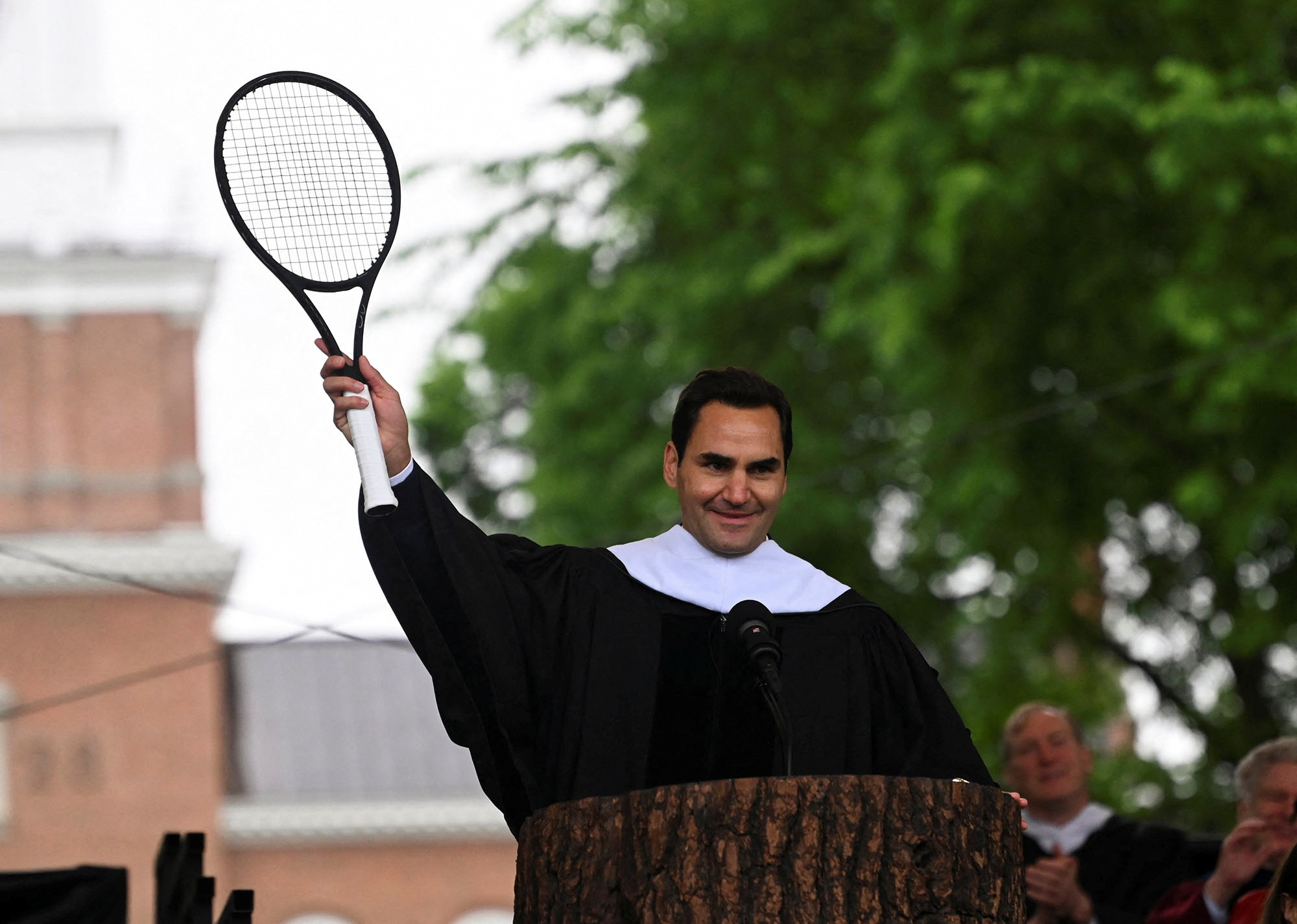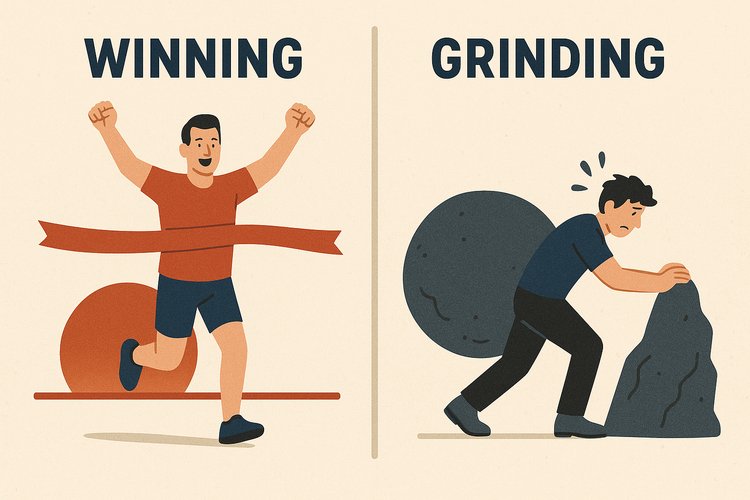The Rhythm Dividend

“You don’t rise to the level of your goals. You fall to the level of your systems.”
—James Clear
Built Differently
In marriage, you learn a lot about your strengths.
But you learn even more about your gaps.
Thanks for reading Beyond The Peak! Subscribe for free to receive new posts and support my work.
Take my wife and I as an example. We have been married just shy of 20 years.
She’s the embodiment of rhythm. She is disciplined, always prepared, always bringing her best regardless of whether she feels like it or not. Predictable in the best way. If consistency were a sport, she’d be on the podium every time. That’s why she was able to say she is going to run her first full marathon and 6 months later, not only finished, but cruised it with a big smile. And now…on to bigger things. All because of her consistency, rhythm, and discipline.
Me? I’m the visionary, focused, intense, all-or-nothing guy.
I thrive in sprints, but rhythm never came naturally. In fact I always found it incredibly boring because I confused it with routine. At university, I couldn’t study three weeks out. I was that guy cramming in a 48-hour grind of adrenaline and caffeine and it always brought out the best in me. Raising my game at the last minute. When it came to fitness, I avoided long 12-week programs like the plague. But I loved CrossFit, structured methodology and programming, but never the same workout twice. That was my jam. Instead of running consistently for 21km I would thrive on intervals for an hour.
But there was a moment that changed how I thought about rhythm.
A few years back I got accepted into a full-time MBA. I went all-in. And for the first time in my life, I didn’t just rely on grit and sprints, I built intentional rhythms into my life. Study blocks. Feedback loops. Sleep schedules. Family time. Accountability to my cohort. I had to. Without it I would not have been able to succeed with the shear volume of work over a short period of time. There was too much at stake. Failure wasn’t an option.
And something strange happened.
Halfway through the program, I realized I was tracking towards a possible Cum Laude.
Me. The guy who never saw himself as an academic. The guy who always figured he’d get by on intuition, work ethic and grit.
I didn’t quite make the cutoff in the end, but I came close. Closer than I ever thought possible.
That season taught me this:
Rhythm doesn’t erase your weaknesses, it activates your potential.
It turns sprints into sustainable progress. It turns ambition into execution.
And if it worked for someone like me? It can work for anyone.

The Rhythm You Don’t Regret
There’s a reason the greatest athletes, investors, and leaders all talk about one thing, compounding.
Because rhythm is where compound lives.
Warren Buffett, the ultimate long-term investor, once said:
“The stock market is a device for transferring money from the impatient to the patient.”
He built almost all his wealth after age 50. Not by chasing quick wins, but by relentlessly compounding small, disciplined decisions.
In the early years, putting $250 a month into a boring portfolio feels pointless. Twenty years later, you look back and wonder how everyone isn't doing this.
Because compounding doesn’t feel rewarding… until it becomes unstoppable.
Rhythm & The GOATs
I see this in my son, a performance swimmer at just age 13 but with huge dreams.
He shows up morning and night, winter and summer, snow or rain, weekends, holidays. He has no idea if he’ll ever reach the levels he is pushing towards. There’s no guarantee. But he shows up anyway.
This story repeats across every great athlete:
- Serena Williams drilling forehands while others sleep.
- Kobe Bryant shooting hundreds of jumpers before sunrise.
- Michael Phelps training every single day, including Christmas, for five straight years.
- It’s been floated that Tiger Woods installed a gym in his private jet, because he literally couldn’t afford to miss a workout while traveling.
They didn’t magically “rise to the moment”—they fell back on their rhythm. They made consistency inevitable.
In a previous edition I shared the video of Roger Federer during his commencement speech at Dartmouth University, talking about his frustration with people saying he always were so effortless and it always looked like he barely broke a sweat. The reality is, that behind all of the so called “effortless” brilliance people say there was decades and thousands of hours of effort consistently over time. (Click on the image below to watch video)

These iconic figures didn’t magically “rise to the moment”, they fell back on their rhythms. They made consistency inevitable.
A good friend of mine once said, he doesn’t take on something he don’t see himself being able to sustain for the next 5 years. That really got me thinking what I take on daily that I cannot sustain for 5 years and actually is distracting me from staying on course.
Why Rhythm > Routine
Now, if you are a fast moving founder or entrepreneur you would say, Jaco, there are no time for this. This will just slow me down. Let me tell you one thing, sometimes you need to go slow to go fast. You cannot afford not to.
Here's the difference between routine and rhythm:
Routine is static, predictable, and easily broken when life gets complicated. Rhythm is dynamic, adaptive, responsive, it moves with you. (I hate routine but I love rhythm)
In sport, we’ve known this for decades. Athletes don’t train at maximum intensity all the time. They cycle through structured periods of stress and recovery. Why? Because the human mind and body aren’t built for flat-out intensity forever. It’s not sustainable. When you alternate between stress and recovery, you adapt, improve, and sustain higher levels of performance. (Bompa, 1999; Selye, 1956). They key is, it needs to be planned !
In business, Jim Loehr and Tony Schwartz observed the same thing. Top performers oscillate between intense effort and renewal. They manage energy, not just time. CEOs who do this make fewer strategic mistakes and sustain higher performance. (Loehr & Schwartz, HBR, 2001)
Rhythm, unlike rigid routine, lets you pause without guilt, rest without falling behind, and push without burnout.
The Founder Rhythm Framework
Here's how I translate these lessons practically into a founder-friendly rhythm:
Daily Rhythms (Deliberate Practice)
- One deep-work block: 90 minutes, no distractions.
- Micro-resets: 5-minute pauses to breathe, move, pray, recalibrate.
Weekly Rhythms (Reflection & Reset)
- 24-hour reset block: Digital off, family and self-care prioritized.
- Friday review: Simple scorecard (Energy, Clarity, Progress).
Monthly Rhythms (Refocus & Recalibrate)
- Half-day offsite: Review progress, rehearse difficult conversations, refine focus.
Quarterly Rhythms (Anchor Vision & Celebrate Wins)
- Retreat Weekend: Refresh vision and values, reset major priorities, and intentionally celebrate progress.
Why does it work? Because each layer builds on the last. Daily actions reinforce weekly resets. Weekly resets build monthly clarity. Monthly clarity fuels quarterly vision.
Just like compound interest: small, rhythmic investments build into massive returns.
As Buffett said perfectly:
“Chains of habit are too light to be felt until they are too heavy to be broken.”
Stick to this framework, and eventually, your rhythm will become so strong that breaking it becomes harder than maintaining it.
Practical Next Steps
- Start Small: Choose ONE daily rhythm you can realistically start tomorrow and maintain over time.
- Create Accountability: Share this rhythm with someone who will hold you to it or build it into a system that keeps you accountable.
- Reflect Weekly: Schedule a simple 15-minute reflection this Friday to review your rhythm progress.
Reflective Prompts
- Where in your week do you currently feel rushed, reactive, or overwhelmed?
- What is one tiny rhythm you can commit to daily that could compound dramatically over time?
- How would your work and relationships shift if your energy was consistently managed rather than drained?
Next Up
In two weeks, we’ll explore "Identity & Flywheels." Rhythms don’t just support your performance, they shape who you become.
Until next time,
Jaco
References
- Bompa, T. O. (1999). Periodization: Theory and Methodology of Training. Human Kinetics.
- Loehr, J., & Schwartz, T. (2001). The Making of a Corporate Athlete. Harvard Business Review, 79(1), 120-128.
- Selye, H. (1956). The Stress of Life. McGraw-Hill.
- Clear, J. (2018). Atomic Habits: An Easy & Proven Way to Build Good Habits & Break Bad Ones. Penguin Random House.
- Buffett, W. (2008). Letter to Shareholders, Berkshire Hathaway Inc.
- The Success Pod [@TheSuccessPod]. (n.d.). Effortless is a Myth | Roger Federer commencement speech at Dartmouth University [Video]. YouTube Shorts. Retrieved May 28, 2025, from
- McGagh, K. (Photographer). (2024). Former tennis pro Roger Federer tells students that 'effortless' is a myth in Dartmouth commencement speech [Photograph]. Reuters; published in The Globe and Mail.
Thanks for reading Beyond The Peak! Subscribe for free to receive new posts and support my work.



